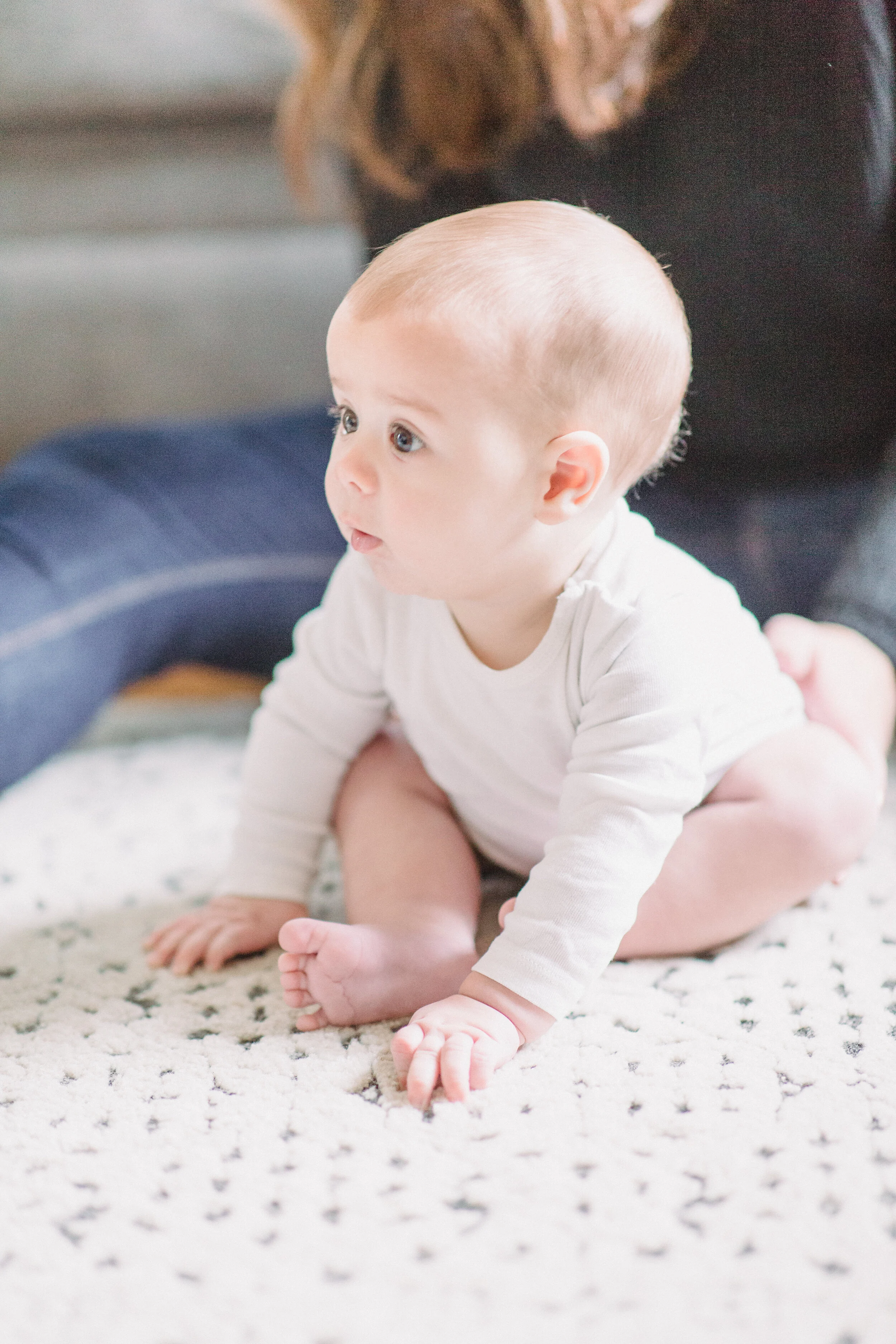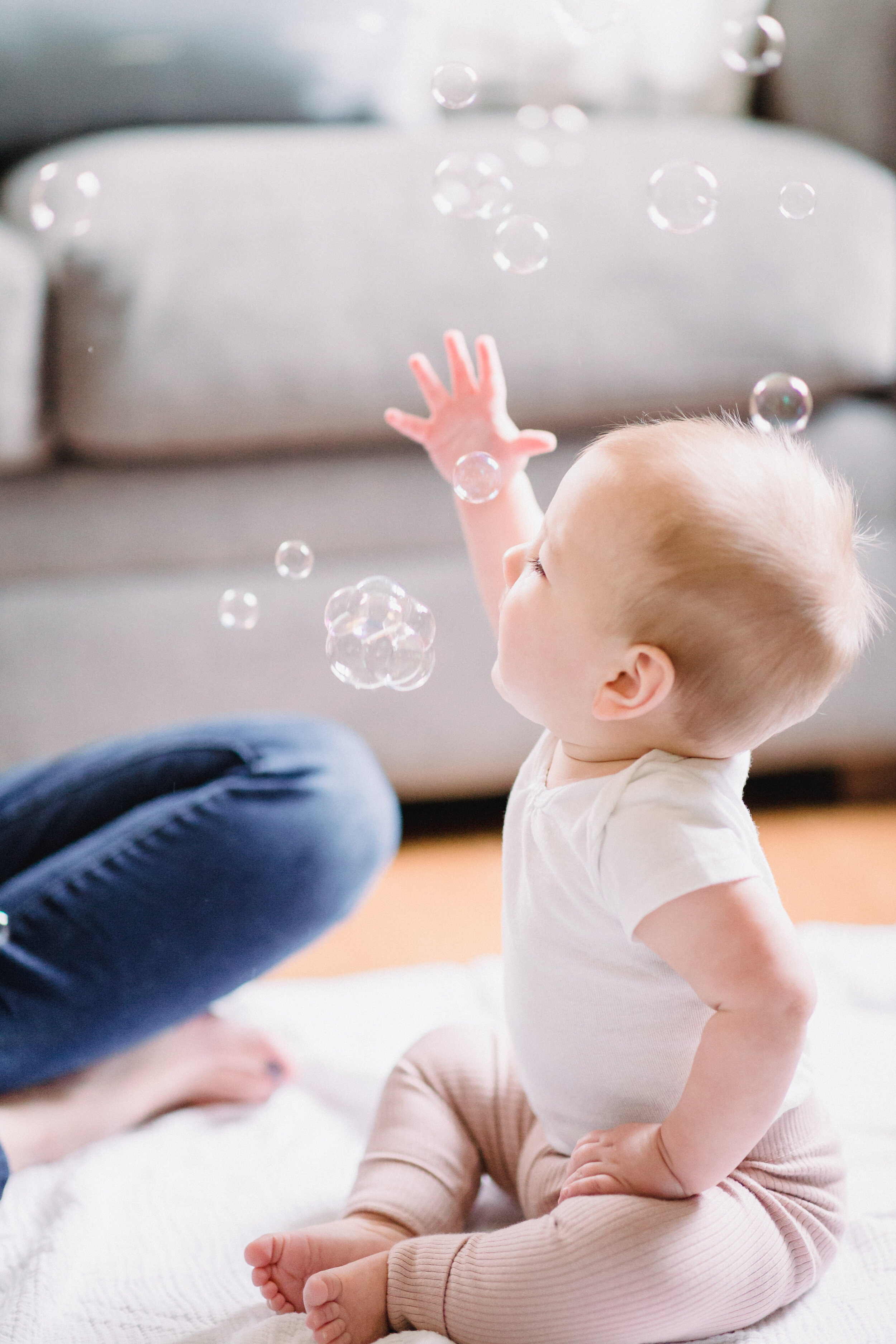Sitting
Did you know that there is a progression to how a baby learns to sit and what they can do once there? Technically a baby isn’t “sitting independently” until she can get into and out of sitting on her own. But, most parent’s say “my baby can sit” when their baby can sit on the floor when placed there by an adult.
Why should you care about this nuance? Well, being placed in sitting but not being able to do anything, reach for anything, play, or get in and out of the position isn’t very functional for baby. And you know we’re all about functional play around here! Below you’ll find the progression of sitting and some play activities you can work on to help your baby progress from being placed there, to playing while sitting, and getting themselves in and out of it.
Happy playing!
Progression of sitting:
Placed in sitting
Prop sitting (sits with arms in front of them, hands on the floor)
Reaching in sitting
Two handed use in sitting
Placed in sitting
Baby begins playing in sitting when you’re helping to support his/her body upright. At first when you take your hands away, baby toddles a little and usually flops backward. When baby is just starting to sit like this, try placing a boppy around his/her hips for a little added support. This will also cushion the fall if your baby topples backward. Always stay near baby when he/she is first learning to sit to avoid injury.
My favorite place to work on sitting is on a bed. Why? Because baby can try reaching, looking, and playing and if they fall, it’s all cushy. Yes, this makes it slightly more difficult on baby’s balance because they’re sitting on a soft surface rather than a flat hard floor, but I think the decreased worry of less head bonking and the added opportunities for snuggles and tickles are totally worth it! Of course, be sure to position baby in the center of the bed to avoid falling off.
Once baby gets the hang of sitting when placed, try sitting in front of baby and singing a song or making silly faces. This will cause her to look up at your face - an added balance challenge and great opportunity to support language development.
Prop sitting
Baby is sitting but is supporting some of his weight on his arms in front of him. This is an important step in the development of sitting, but it’s not very functional if he can’t use his hands to play or do anything while he’s there!
To progress past prop sitting, sit in front of him, facing him. Try playing with a burp cloth, blanket, or favorite stuffed animal, something fairly flat. Slowly shake/move it around on the floor in front of his right hand to encourage a little reaching and unweighting of that arm.
Place your other hand on his opposite (left) hip to help it stay connected to the floor. Baby will want to topple toward the right as he’s starting to learn to reach in sitting and your added support at the hip (slight downward pressure) will help keep his buns on the floor and give him a better sense of what trunk muscles to start using when reaching.
Reaching in sitting
Reaching and playing in sitting is a very functional skill that then leads to baby learning how to sit and eat, sit and do homework, sit and do a puzzle, etc.… Whatever it is you do in sitting, you almost always want your hands free to do something while you’re there, so this is a big milestone to celebrate!
This is also around the time you might try putting baby in the seated section of the shopping cart while you’re out and about (close supervision and a safety belt at all times). What a breath of fresh air to not have to donn a carrier or lug in a baby car seat that takes up all the basket space!
Low reaching:
Once sitting steadily, getting him to reach for things on the floor or near his feet will help get his trunk strength, endurance and balance ready for more complex reaching and moving while seated. When baby looks upward in sitting, it challenges his balance more so start low and then move on.I love to work on reaching for things down low on the floor like a block or shape from the shape sorter. Try placing it just out of his reach - somewhere near his toes but as far back as his hips - wiggling or tapping it on the floor to get him interested. You could also try making a short tower and encouraging him to knock it over by reaching. Once he’s reaching for things on the floor, move on to overhead reaching.
Overhead reaching:
Try holding his favorite ball, rattle, or other toy at eye level and shaking it there. Wait for him to balance himself (often looks a little wobbly and slow in the trunk) before he reaches. Celebrate the heck out of him getting the toy and help him bring it close to his body or to his mouth if he’s interested. This allows him to check out the object close to his body, easier than holding it with an extended arm away from the body.
For a big balance challenge, try holding a rattle or other fun toy above his eye level and getting him to reach up for it. Watch what happens to his back! He will go from a hunched/turtled (flexed) position when reaching toward the floor to an extended and elongated position as he reaches forward and upward. This is working the back, neck, shoulders, and visual system big time. Try it on a bed or with a boppy or pillow behind him just in case he falls.
Two handed use in sitting
Once baby is able to hold two toys and bang them together or reach to put them into a container, they’re showing some nice advanced sitting skills! This two handed use shows that their core is more stable and they don’t have to use all of their energy to stay upright but can now move on to playing - a much more functional skill!
Once baby can do this consistently, try challenging baby to reach for items you hold out in the air. Move the placement around and change giving a toy on the left and right sides.
Great work on getting your baby upright and playing in sitting! It is a progression, but is worth the effort you and baby have put in. Sitting is a milestone but is also a functional skill required for eating and playing. Now that you have a confident sitter you can play all sorts of fun games on the floor like peek-a-boo, read books or bang toys. You can also rest easy knowing that your baby is strong enough to sit, eat, and play with the fun foods you’re about to offer. Have fun, and as always, reach out if you have any questions.
The next phase after playing in sitting is getting in and out of sitting. A baby who can get in and out of sitting on their own is technically an “independent sitter” so check our post on that transition (coming soon).
-Bree
We’re Bree & Jaclyn
Pediatric therapists and moms with a mission to empower you with knowledge to encourage your baby’s development and continue confidently into your parenthood journey.
If you have any questions, please feel free to leave a comment below and we will get back to you. As always, the information we share is meant to provide general education and tips and is not intended as medical advice. If you have a specific question or concern about your child’s development, please speak directly to your child’s doctor or therapist.
References:
Karasik, L. B., Tamis-LeMonda, C. S., Adolph, K. E., & Bornstein, M. H. (2015, September). Places and postures: A cross-cultural comparison of sitting in 5-month-olds. Journal of cross-cultural psychology. Retrieved October 25, 2021, from https://www.ncbi.nlm.nih.gov/pmc/articles/PMC4767024/.
Sato, N. T. da S., & Tudella, E. (2018, June 25). Influence of sitting positions and level of trunk control during reaching movements in late preterm and full-term infants. Frontiers in pediatrics. Retrieved October 25, 2021, from https://www.ncbi.nlm.nih.gov/pmc/articles/PMC6026931/.
Soska, K. C., Robinson, S. R., & Adolph, K. E. (2015, March). A new twist on old ideas: How sitting reorients crawlers. Developmental science. Retrieved October 25, 2021, from https://www.ncbi.nlm.nih.gov/pmc/articles/PMC4294991/.









